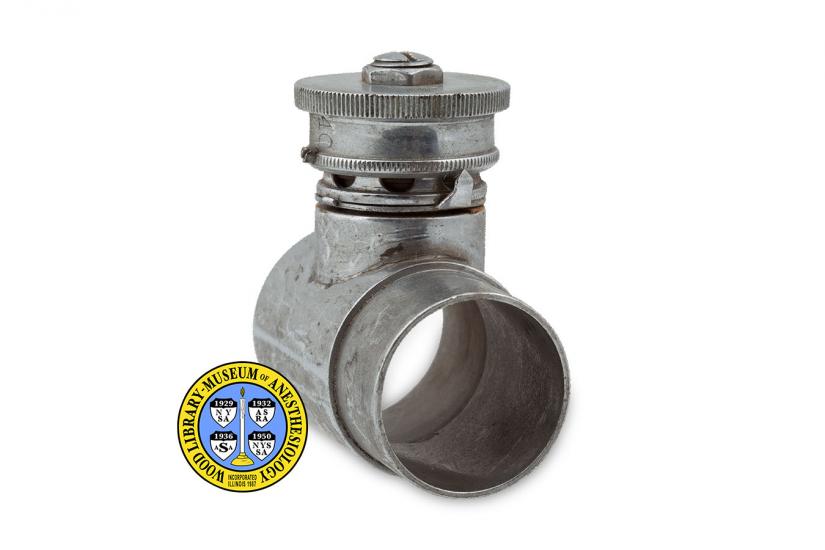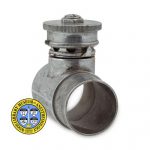Heidbrink Valve
For safety, anesthesia machines are constructed with pressure relief valves of various designs. The purpose of the valve depends upon its location in the machine’s systems. Often they are employed to prevent too high a pressure of air and gas from being delivered to the patient or to the next functional part of the machine.
A Heidbrink Valve is an adjustable expiratory valve used to permit exhaled air from the patient to pass back into the breathing system while preventing the entry of air from outside the breathing system. It also lets air escape if pressure in the system reaches or exceeds a set level on the valve.
Dr. Jay A. Heidbrink may have first described this valve in a patent that he filed in 1929 for a ventilator. ‘Heidbrink Valve’ has become a common name for valves of similar design that can be found on many manufacturers’ anesthesia machines.
Dr. Heidbrink was a dentist and an early designer and manufacturer of innovative nitrous oxide-oxygen and ether anesthesia equipment. His contribution to advancements in anesthesia was not limited to equipment design, he also refined an anesthesia technique, sometimes called “timed anesthesia”. Via many teaching demonstrations he taught other anesthesiologists and dentists how to use his equipment and employ his technique. In 1954 Heidbrink became the first recipient of the American Dental Society of Anesthesiology's annual achievement award, which is now named in his honor.
Catalog Record: Heidbrink Valve
Access Key: akxf
Accession No.: 113
Title: [Heidbrink pressure limiting valve.]
Author: Heidbrink, Jay A., 1875-1957.
Title variation: Alt Title
Title: Heidbrink valve.
Title variation: Alt Title
Title: Heidbrink expiratory valve.
Publisher: [Place of manufacture not indicated] : [Name of manufacturer not indicated], [between 1929 and 1944].
Physical Descript: 1 safety valve : metals ; 6 x 3.5 x 5 cm.
Subject: Pressure Releif Valves.
Subject: Safety.
Subject: Anesthesia, Inhalation – instrumentation.
Subject: Pressure – instrumentation.
Subject: Heidbrink, Jay A., 1875-1957.
Note Type: General
Notes: The early date in the date range is a rough estimate based on a patent filled
by Dr. Jay A. Heidbrink in 1929, and granted in 1933 (patent 1,917,940). In
this patent is a valve, ” … with a seat which is engaged by a disk valve
normally held against this seat by a coiled spring … .” This may be a
description of an early version of the ‘Heidbrink Valve.” The late date is
based on the 1944 inventory performed by Dr. Wood which included this valve.
The date range could change if reliable information indicates that the range
should be corrected.
Note Type: General
Notes: Because this type of valve seems to have been a part of new machines built by
Dr. Heidbrink, rather than a separately patented invention, it of came to be
known as the ‘Heidbrink Valve’ through common usage. The earliest reference
found to a Heidbrink Valve in the literature is from 1949, where it is
described in the British Medical Journal as being part of the Kreiselman
Resuscitator. For this reason the title was taken from the 1944 inventory
card created by Dr. Wood.
Note Type: Citation
Notes: Dorsch JA, Dorsch SE. The breathing system: I. general considerations. In:
Understanding Anesthesia Equipment. Baltimore: Williams & Wilkins;
1975:147-148.
Note Type: Citation
Notes: Heidbrink JA, inventor. Pulmonary ventilating apparatus. US patent 1,917,940.
July 11, 1933.
Note Type: Citation
Notes: Heidbrink JA. Memoirs. Anesth Hist Assoc Newsl. April, 1987;5(3):6-8, 12.
Note Type: Citation
Notes: Lee JA. Nitrous oxide anaesthesia. In: A Synopsis of Anaesthesia. 2nd ed.
Baltimore: Williams and Wilkins Company; 1950:94.
Note Type: Citation
Notes: Mushin WW, Mapleson WW. Pressure-flowrate characteristics of expiratory
valves: with some suggested criteria for an ideal valve. Br J Anaesth.
January, 1954;26(1):3-10.
Note Type: Citation
Notes: Preparations and appliances: a portable resuscitator. Br Med J. March 26,
1949;1(4603):541.
Note Type: Citation
Notes: Stebbins HM. Presentation address, honoring Doctor Jay A. Heidbrink on Sunday
November 7, 1954 at the Belmar Hotel, Miami Beach, Florida, at the first
annual meeting of The American Dental Society of Anesthesiology. Newsmonthly.
April 15, 1955;2(4):2-4.
Note Type: Citation
Notes: Rendell-Baker L. The development of nitrous oxide-oxygen apparatus. Anesth
Hist Assoc Newsl. January, 1992;10(1):11-12, 16.
Note Type: Citation
Notes: We salute … Dr. Jay A. Heidbrink, 1875-1957. Anesth Analg.
September/October, 1958;37(5):23-24.
Note Type: Citation
Notes: Yentis SM, Hirsch NP, Smith GB. Adjustable pressure-limiting valves. In:
Anaesthesia and Intensive Care A-Z: An Encyclopaedia of Principles and
Practice. 4th ed. Edinburgh: Churchill Livingstone/Elsevier; 2009:9.
Note Type: Physical Description
Notes: One metal, adjustable, pressure relief valve; The measurements were taken
with the valve’s top facing upward and the female end of the tubing
connection facing the cataloger; The valve is topped by an adjustable
screw-cap; When the cap is turned, a part of the valve that is marked with
numbers also turns; The numbers are engraved and include, “10”, “20”, “30”,
and “40”; The numbers are rotated around a small, stationary pointer; The
pointer is located just below the rotating top of the valve, near the female
tubing connection; Small round perforations line the valve horizontally to
allow for the escape of pressure; The functional parts of the valve are
connected to metal tubing that has a male end and a female end so that it may
be inserted into the expiratory tubing of an anesthesia breathing system;
There are no manufacturer markings; The last name, “WOOD” is hand engraved
into the top of the valve.
Note Type: Reproduction
Notes: Photographed by Mr. Steve Donisch, September 20, 2013.
Note Type: Historical
Notes: For safety, anesthesia machines are constructed with pressure relief valves
of various designs. The purpose of the valve depends upon its location in the
machine’s systems. Often they are employed to prevent too high a pressure of
air and gas from being delivered to the patient or to the next functional
part of the machine.
Note Type: Historical
Notes: A Heidbrink Valve is an adjustable expiratory valve used to permit exhaled
air from the patient to pass back into the breathing system while preventing
the entry of air from outside the breathing system. It also lets air escape
if pressure in the system reaches or exceeds a set level on the valve.
Note Type: Historical
Notes: Dr. Jay A. Heidbrink may have first described this valve in a patent that he
filed in 1929 for a ventilator. ‘Heidbrink Valve’ has become a common name
for valves of similar design that can be found on many manufacturers’
anesthesia machines.
Note Type: Historical
Notes: Dr. Heidbrink was a dentist and an early designer and manufacturer of
innovative nitrous oxide-oxygen and ether anesthesia equipment. His
contribution to advancements in anesthesia was not limited to equipment
design, he also refined an anesthesia technique, sometimes called “timed
anesthesia”. Via many teaching demonstrations he taught other
anesthesiologists and dentists how to use his equipment and employ his
technique. In 1954 Heidbrink became the first recipient of the American
Dental Society of Anesthesiology’s annual achievement award, which is now
named in his honor.
Note Type: Exhibition
Notes: Selected for the WLM website.


